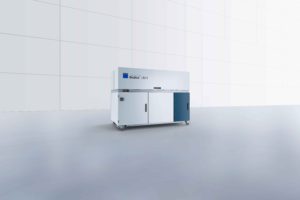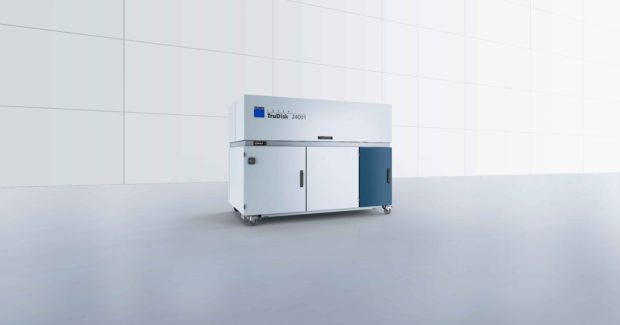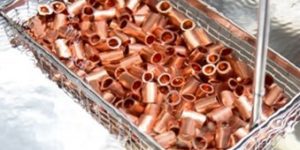Sheet Cutting Lasers and the Great Decision
At the end of the day, the decision about laser power, like any good investment decision, should be based on profitability.
Posted: October 20, 2022

Technology has evolved considerably during the decades in which sheet cutting lasers have been used. Machines have become faster, more automatic, and easier to operate, while laser sources have become more efficient, more reliable, and more capable. The best sheet cutting lasers today can perform three times as much useful work as comparable machines from 15 years ago, while requiring fewer man-hours to program, operate and maintain. Automation systems are available to make light work of loading and unloading sheet stock. All these improvements greatly help to justify a new laser machine investment. Still, one important decision facing equipment buyers does not seem to have become simpler, specifically: how much laser power do I need?
The technology that has made laser sources more useful over the last couple of decades has also made them easier to scale than ever before. The result is a proliferation of laser powers available for cutting, because achieving higher laser power is, in theory anyway, simply a matter of stacking more of these very scalable lasers together. There is good reason to wonder, though, how much of an increase in laser power output will generate a return on investment? To answer that question, we need to understand what additional laser power can do for us compared with what it will cost.
What Combination of Machine Platform and Laser Power do I Need?
Let’s consider first the potential benefits of higher laser power. The obvious answer is more power equals more cutting speed, which equals more production throughput. In many cases this is true. Having more energy to throw at the sheets of raw material will translate directly into more cut parts per hour. The speed of cutting depends as much on laser power and assist gas as it does on the moving axes of the machine platform, though. This means, to turn our higher laser power directly into production speed, at a minimum we need a mechanical drive system that matches up well with the laser power we choose. A very high-output laser on a machine not built to support it will work about as well as taking a standard family sedan and putting a racing motor in it. This means that the decision facing us is not really “what laser power?” as much as “what combination of machine platform and laser power?” to choose from.
On the other hand, if cutting time seriously outpaces the rest of the factory processes, this productivity gain may not produce a net benefit. In this case, automation for loading and unloading the laser may become necessary in order to support our increased cutting speeds. Additionally, in thinner materials (roughly 3/16-inch thickness and under) there is clearly a diminishing return in terms of cutting throughput as laser power increases beyond a certain point. For most solid-state (1µm wavelength) lasers that we would be likely to consider buying today, that threshold is going to be somewhere around 10,000 watts of laser power. As we increase our laser power further, the amount of time saved per part shrinks, making it harder to justify the higher cost. Eventually the cut speed is limited by how quickly melting metal can be removed by a flowing gas — even this process has physical limits. If our goal is to have the best possible throughput in thinner sheet thicknesses, overall laser power might not be the most important consideration for our new cutting machine.
Another potential benefit of increased laser power would be our ability to cut through thicker materials. More particularly, our ability to cut thicker materials with nitrogen or mixed-gas cutting techniques. Here we see those laser power levels above 10 kW shine. Cutting speed and edge quality improve together with increasing laser power when we are processing materials from around ¼-inch thickness and up. The limit for fusion cutting of mild steel also increases with power, allowing for oxide-free cutting through a larger material range. Because the cutting speeds and acceleration rates in these thicker materials are generally not approaching the dynamic limit of the machine drives, we have a lot of “headroom” to take advantage of the cutting throughput that the laser power brings. High laser power can also open up the ability of cutting with high quality in thicker structural plates that previously would have been outside the range of sheet cutting machines.
To see the full advantage of these benefits, namely increased cutting speeds and increased thickness capacities, we know that our machine platform must be built with our increased laser power taken into consideration. To increase the speed of the cutting unit itself, without sacrificing any precision in the cutting geometry, requires a whole host of supporting design elements. The frame of the machine must be rigid enough to resist the dynamic loading when we start and stop the cutting unit, otherwise we will see geometry tolerance become a problem at very high speeds, and we might even transfer vibrations from the frame to the worktable of the machine, causing more serious deviations in part quality. The worktable may also need to be reinforced if it is expected to handle heavy structural materials.
We also need motors that are strong enough to generate very high jerk factors. The jerk factor is the 3-dimensional equivalent of acceleration, and to visualize its importance, it is useful to imagine a vehicle accelerating. If you took a still image of the vehicle at one moment in time, it would have a certain acceleration rate, but to understand how the vehicle’s speed changes over a whole series of moments we must use 3-dimensional acceleration values, or jerk factors. A vehicle with a very high jerk factor is a racecar. The vehicle can change its rate of acceleration very quickly over a span of time, so it gets up to speed rapidly. A machine capable of achieving high jerk factors will likewise win any race against a machine with lower jerk factors. Even that is only part of the story though, because without excellent motion control to support those big motors, moving at very high acceleration will cause our machine to deviate from the desired path and create bad geometry: egg-shaped holes instead of round ones, or 90-degree corners that are not really square. A machine like this in our racecar analogy would be a vehicle that could get going fast in a straight line but not stop or turn very well.
Based on this we can evaluate whether higher laser powers will deliver us a good return, and we also know that we have to evaluate the capabilities of the machine platform as a whole rather than just consider the available wattage. If we expect a steady diet of materials over ¼-inch thickness to dominate our new machine’s working time, if we have a need to clean-cut mild steel as thick as we possibly can, or if we have a use for the ability to cut very heavy plates with laser quality, it is well worth considering a very high-power laser solution. On the other hand, if our machine’s regular workday will be mostly thinner materials, with only an occasional need to process thicker plates, a lower laser power might just be more efficient in doing that work. At the end of the day, the decision about laser power, like any good investment decision, should be based on profitability.
Subscribe to learn the latest in manufacturing.


















